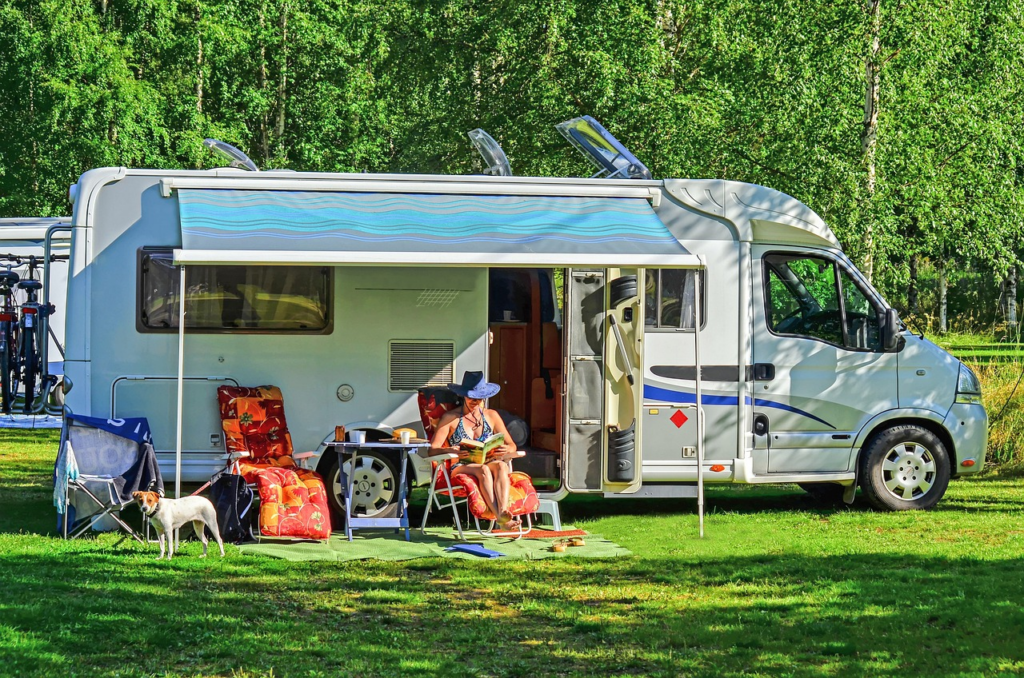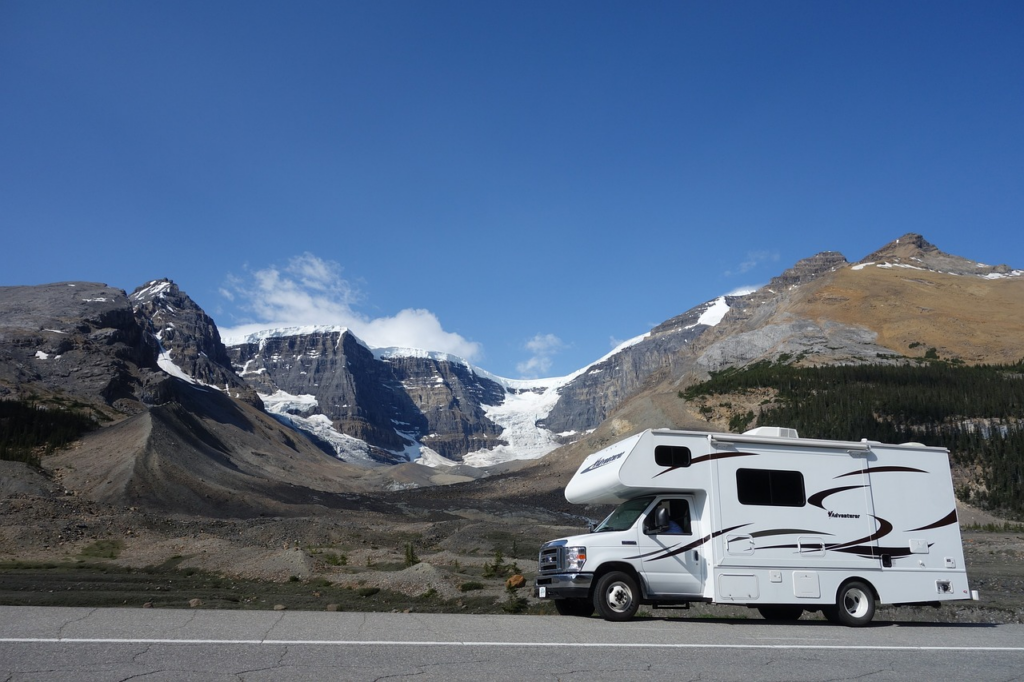Ever wondered what it’s like to live in an RV full-time? This guide has the answer!
Having a home on wheels comes with a number of perks, from constantly changing scenery to the freedom to travel anywhere in the country! Though, RV life it isn’t all wide open spaces and scenic views. The magic of full-time RV living will certainly come at a cost.
Of those one million Americans who choose this RVer lifestyle, most will make serious adjustments to enjoy the perks of full-time RV living.
This blog will inform you of the costs, benefits, and essentials of living full-time in a home on wheels.
Why Adopt RV Living Full-Time?

Full-time RV living is one of the best ways to live in the moment. With this approach, you can drive to any destination on a whim without worrying about packing or hiring house sitters. With an RV set as your travel mode, you can save so much money on travel tickets and hotel stays!
However, this lifestyle has several other benefits, including:
Affordable Lifestyle
Buying an RV is more affordable than purchasing a home. On average, an RV costs between $10,000 and $400,000. Conversely, purchasing a house can cost you a minimum of $416,100. Additionally, with full-time RV living, you don’t have to spend on property taxes and housing expenses.
Freedom to Move Anywhere
Renting, or having a mortgage, ties you down and restricts your travel. If you want to go on an extended trip, you’ll not only need to find a house sitter, but you’ll have to continue to pay rent, too.
If you rent an apartment, hiring a house sitter may not be necessary. However, a several-month trip will mean you’re paying hundreds, even thousands of dollars a month to rent an apartment you’re not living in. (Note: Should you decide to terminate your rental contract in favor of full-time RV living, you’ll need to give 1 to 2 months’ prior notice).
In contrast, full-time RV living lets you explore any state whenever you want (without monthly mortgage or rental costs weighing you down). You can also earn on the road by taking on contractual or remote jobs, like a content writer or a virtual assistant, for a steady income.
Enjoy Breathtaking Views
With full-time RV living, you can take your home on wheels to stunning locations. Embracing this lifestyle lets you reside by the coast or in the midst of mountains. You can park your motorhome wherever you wish and enjoy picturesque surroundings!
Lead a Simple Life
Living in an RV full-time helps you simplify and tidy up your life. Unlike traditional housing, RVs have a constricted space, which compels you to eliminate unnecessary clutter.
However, full-time RV life does not mean you get rid of sentimental items. If you lack storage, you can rent a self storage unit through platforms like Neighbor.
How Much Does Full-Time RV Living Costs?
The cost of full-time RV living can be as low as $1,000 or jump up to $5,000, depending on your spending habits and lifestyle preferences. However, there are some fixed costs you must pay when living the full-time RV life:
Campground Fees
Private campgrounds charge a $25 to $80 camping fee to park your mobile home. The fee varies depending on the location, camper size, and facilities available at the campground. These charges also cover using amenities like electricity, water, internet and cell services, dump areas, hot tubs, entertainment sections, exercise equipment, and more.
Check out some of the well-renowned campgrounds and their fee structure to select one that suits your budget and comfort preferences:
|
Campground |
Fees |
|
Inn Town Campground – Nevada City, California |
$50 – $75 |
|
Yogi Bear’s Jellystone Park – Mill Run, Pennsylvania |
$50 – $62.50 |
|
Sun Outdoors Lake Rudolph – Santa Claus, Indiana |
$30 – $55 |
|
Ramblin’ Redwoods – Crescent City, California |
$32 – $67 |
If you want to go for a lower fee, consider basic national parks. These come at a relatively lower cost but only provide the fundamental necessities, including electricity, sewerage, and water supply.
Fuel Costs
Adopting a full-time RV lifestyle can lead to higher gas costs, especially if you frequently change locations. Filling an empty RV tank with gas can cost up to $300 with gasoline and around $400 with diesel.
The exact amount is based on your motorhome’s tank size and the current fuel rates. To save on expenses, consider staying in one spot for a few months rather than moving frequently.
Additionally, traveling with less weight can improve mileage and ease the strain on your engine. You can also save on gas by filling up in states with lower fuel prices, like Mississippi, Alabama, Arkansas, Tennessee, and South Carolina, where a gallon of gas costs around $3.
Grocery Expenses
In full-time RV living, dining out daily isn’t necessary. Instead, you can save on food costs by cooking your meals. This way, you can enjoy tasty, budget-friendly, and nutritious dishes whenever possible. But remember that you’ll need propane to power your stove, which typically costs around $2.67 per gallon.
Ways to Live a Full-Time RV Life, Affordably

There are various ways you can make full-time RV living more affordable. Let’s take a look:
Practice Boondocking
Boondocking, also known as dry camping, is a self-reliant way of RV living. With this method, you won’t have access to water, sewage, or electrical hookups unless you onboard your RV’s water tanks, batteries, and generators.
You can boondock in parking spaces, rest stops, or natural settings (such as Lake campsites or forests). This approach can help you save camping fees, especially during longer stays.
Join Camping Clubs
Many camping clubs (such as Escapees RV Club) offer discounts to members, like free boondocking, cheaper RV insurance, and road assistance. Joining the right club can help you save money during RV living based on your needs.
Indulge in Free Sightseeing
As full-time RVers, you’ll naturally want to explore various places and visit famous attractions. However, the cost of admission fees to the popular spots can strain your budget.
To manage this, opt for destinations with affordable or free admission. State parks, local theme parks, zoos, and museums often offer budget-friendly experiences.
Additionally, look for discounts you might qualify for, like those for military personnel, seniors, homeschoolers, or AAA members.
Use Free WiFi
A dependable internet connection is essential if you’re a freelancer or work remotely. Instead of splurging on costly cell service, choose an RV park that provides free public WiFi. Many private RV parks and campgrounds offer complimentary WiFi.
Alternatively, you can save on internet expenses by visiting coffee chains like Starbucks, which often provide free WiFi access.
3 Signs You’re Prepared for Full-Time RV Living
These are some changes you must be ready to make if you want to shift to full-time RV living:
You’re Ready to Make Sacrifices
Embracing a minimalist mindset is key when living in an RV full-time. Limited space means packing only essentials and leaving behind the excess. You’ll also need compact, collapsible kitchenware to maximize space. Be ready for regular maintenance, too; constant travel can lead to wear and tear from road conditions.
You’re Finding New Ways to Earn
In this lifestyle, traditional 9-to-5 jobs may not be feasible. Therefore, expanding your skills to earn an income on the road is essential. You can explore careers like virtual assisting, blogging, technical work, contractual construction work, online teaching, or customer service.
You can also find seasonal opportunities on platforms like Workamper to sustain your income on the road.
You Love to Plan
Full-time RV living requires planning. For instance, when traveling, you must plan your routes, make the most of your limited space, find suitable RV parks, and be prepared for unexpected situations.
Additionally, when transitioning to RV living, you must establish a dependable mailing address to receive mail and ensure that your RV insurance is always current.
How to Pack for Full-Time RV Living?
One of the primary hurdles in full-time RV living is choosing what to bring. Given the constraints of limited storage space, here are some strategies to help you pack efficiently for your RV lifestyle:
Basic Items
Basic items are the must-haves for full-time RV living. This list includes:
- Drinking water hose for clean water supply
- Blankets, pillows, and sleeping bags
- Shirts, pants, raincoat and jackets
- Underwear and socks
- Sneakers, trekking shoes, and house slippers
- Toothbrush, toothpaste, shampoo, body wash, and lotion
Emergency Items
Emergency items ensure you are always prepared to resolve any issue when RV-ing full-time. So, make sure to pack these things in your emergency kit:
- Spare RV parts to replace damaged ones
- Screwdriver, wrench, and other maintenance tools to take off faulty parts
- Spare tires to replace punctured or burst tires
- USB batteries for night
- Jack pads and wheel chocks to level your rig’s jacks
- Medical kit for injuries
- Health insurance and RV insurance documents
Kitchen Items
These essential kitchen items can help you save space and ensure you have everything you need for your full-time RV adventure:
- Coffee maker
- Wine and can opener
- Plates, pots, pans, glasses, and utensils
- Cutting board
- Stove or grill
- Dish towels
- Trash bags
- Storage containers
Considerations for Efficient RV Packing
You have to pack multiple items if you are boondocking your camper van. For instance, you need more camping supplies like outdoor tables, lanterns, and coolers to relax outside.
However, if private RV parks are your thing, you need a propane fire pit, kayaks, hammocks, or golf clubs to make the most of your stay.
How to Buy a Rig for Full-Time RV Living?
If you are shifting toward the RV lifestyle, use these guidelines to purchase the right rig:
- Size: Your camper’s size must accommodate all the family members.
- Layout: The layout must fit your daily requirements, such as closed office space for work
- Tank Size: The size of the fresh water tank, black tanks (which hold toilet waste), and gray tanks (which hold wastewater from the kitchen sink) must be sufficient for long trips.
Wrapping Up
Ready to join the community of full-time RVers? Find the perfect RV, plan your route, find a remote job, and pack up your motor home with essentials and emergency supplies.
If you’re downsizing, find the perfect self storage option through platforms like Neighbor to keep your belongings safe when you’re on the road!
FAQs
How do I earn an income while living in an RV full-time in an RV park?
Some options include remote work, freelance gigs, seasonal jobs, or even starting an online business. Some full-time RVers also work at camp, taking on temporary jobs at campgrounds.
How do I choose the right RV park or campground?
You must research and plan ahead. Look for parks that offer the necessary amenities, such as hookups, Wi-Fi, and proximity to attractions. Read reviews and seek recommendations from other RVers.
What should I do with mail and legal residency?
Set up a permanent mailing address through RV mail forwarding services or by entrusting dependable friends or family. However, establishing legal residency varies by state and may require research and documentation.







